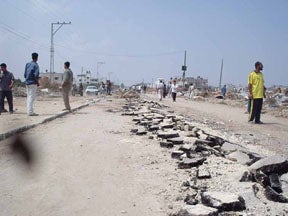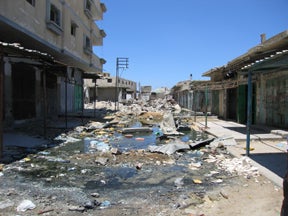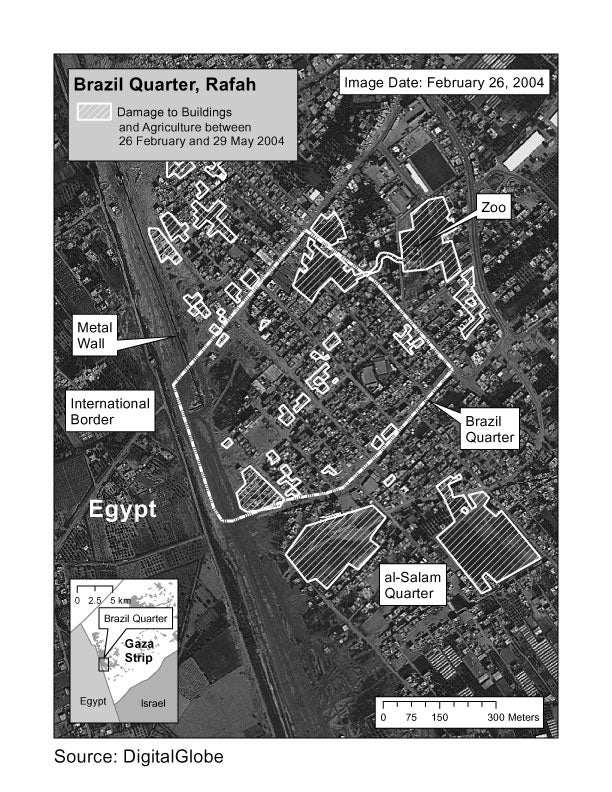<<previous | index | next>>
Map 8: Brazil Destruction During Operation Rainbow
The adjacent satellite image shows some of this destruction, based on imagery analysis and ground-level assessments by Human Rights Watch researchers. Much of the destruction rendered homes uninhabitable without completely collapsing them, thus making them more difficult to detect from above. In addition, the restrictions placed by the U.S. government on the quality of satellite imagery of Israel/OPT make this assessment a necessarily conservative one.
Infrastructure Destruction
According to the Rafah Municipality, the IDF destroyed 51.2% of the city’s roads during the May incursions.267 In addition to the obvious problems this causes for traffic of commercial vehicles, health care workers, and others, the road demolitions caused severe destruction of civilian infrastructure, such as water, sewage, and the electrical grid, as pipes and wires were severed during the shredding of roads. Human Rights Watch’s analysis suggests that such ancillary destruction served no military purpose and could have been avoided.

A road in Beit Hanoun, northern Gaza Strip, destroyed by the rear blade known as the "ripper" of a CAT armored bulldozer, deployed by the IDF. (c) 2004 Palestinian Centre for Human Rights
Damage to the water system affected a water network that, according to UNDP and the Palestinian Ministry of Planning, was already “old, worn and polluted.”268 According to the Rafah Municipality, thirty-six out of fifty-five kilometers of water pipes were damaged in the neighborhoods of Tel al-Sultan, Brazil and Salam. Twenty-seven out of thirty-five kilometers of sewage pipes were damaged in the same area.269
The destruction of water and sewage pipes, and especially their mixing, may lead to waterborne disease. Indeed, traces of polio have been detected in the water supply.270 According to the UN, some seventy percent of common illnesses in the area stem from water pollution.271

Drinking and sewage water mix in Block O after IDF forces destroyed roads and pipes during May.
(c) 2004 Marc Garlasco/Human Rights Watch
IDF tanks and bulldozers also caused extensive damage to the electrical grid, breaking electricity poles, cutting wires and destroying transformers. According to the Gaza Electrical Distribution Company (GEDCO), the cost of damage to the electrical infrastructure was U.S. $150,005. This destruction comes on top of repeated damage over the past four years. The GEDCO transformer near Salah al-Din gate, for example, has been damaged or destroyed eight times since September 2000.272
Without electricity during the operation, the water wells and waste water pumping station in Tel al-Sultan could not function, and the municipality needed UNRWA and ICRC help to get a technician to the area with fuel for the generator.273 The main pipe lines to Rafah were undamaged, but no water made it to Tel al-Sultan for ten days. Three young men were shot by Israeli snipers on May 19, and one of them killed, when they went outside in violation of a twenty-four hour curfew to fill bottles with water (see case of Abu Libda family above).
As discussed above, destruction of roads on the general assumption that such threats existed everywhere contravenes principles of international humanitarian law. And in addition to the protection for civilian property normally granted under humanitarian law, water and sewage infrastructure is especially important due to their importance to the survival of the civilian population. As Article 54(2) of Protocol I Additional to the Geneva Conventions states:
It is prohibited to attack, destroy, remove or render useless objects indispensable to the survival of the civilian population, such as … drinking water installations and supplies and irrigation works, for the specific purpose of denying them for their sustenance value to the civilian population or to the adverse Party, whatever the motive, whether in order to starve out civilians, to cause them to move away, or for any other motive.274
At different times, the IDF has given three rationales for road destruction: To clear a path free of IEDs, to sever wires used to detonate IEDs275, and to protect against suicide car attacks.276 The manner in which the roads were destroyed, however, was not consistent with the stated intents.
In Rafah, the IDF used a blade on the back of the Caterpillar D9 called the “ripper” to destroy roads (see Box 5). In the West Bank and other parts of Gaza, the IDF has frequently dragged the ripper across a street to create a speed bump or barrier to block suicide attacks. But in the May incursions, the IDF dragged the ripper down the middle of streets, creating a long line of broken asphalt and dirt. Because the ripper can penetrate 1.7 metes (five feet, five inches) into the ground, it severed water and sewage pipes along the way.
It is unclear how use of the ripper in this manner would clear IEDs because the blade is on the bulldozer’s back. On the contrary, ripping up paved roads might have facilitated the planting of explosives as debris can be used to conceal an explosive device.
Speed-bumps caused by the ripper when dragged across a road can be an effective way to hinder suicide bombers, and Human Rights Watch researchers observed such speed-bumps throughout Gaza, outside of Rafah, in close proximity to settlements and IDF positions, like checkpoints. The use of the D9 ripper to destroy down the middle of the street, however, merely divides the road into two lanes and is ineffective at slowing down high-speed vehicles on roads such as those destroyed in Tel al-Sultan and Brazil, which are approximately ten meters wide and were designed for two-way traffic.
[267] Rafah Municipality Assessment, June 9, 2004.
[268] UNRWA and OCHA, Rafah Humanitarian Needs Assessment, June 6, 2004.
[269] Ibid.
[270] Human Rights Watch interview with Joachim Paul, UNICEF, Gaza City, July 12, 2004.
[271] UNRWA and OCHA, Rafah Humanitarian Needs Assessment, June 6, 2004.
[272] Ibid.
[273] Human Rights Watch interview with Rafah City Manager Dr. Ali Shehada Ali Barhoum, Rafah, July 15, 2004.
[274] The prohibition does not apply if such objects are used solely as sustenance for enemy armed forces or if they are being used to directly support military action, though “in no event shall actions against these objects be taken which may be expected to leave the civilian population with such inadequate food or water as to cause its starvation or force its movement” (Protocol I, Art. 54(3)). “As regards the objects which are especially protected, the Conference mentioned agricultural areas for the production of foodstuffs, drinking water installations and supplies, and crops, which should be interpreted in the widest sense, in order to cover the infinite variety of needs of populations in all geographical areas” (ICRC, Commentary to Protocol I, p. 655).
[275] Letter from Major Sam Wiedermann, Head of International Organizations Desk, IDF Spokesperson’s Unit, to Human Rights Watch, August 22, 2004.
[276] Human Rights Watch interview with Major Assaf Librati, Spokesman, IDF Southern Command, Tel Aviv, July 25, 2004.
| <<previous | index | next>> | October 2004 |

